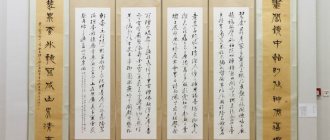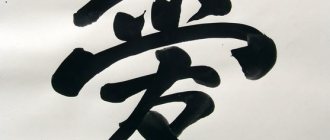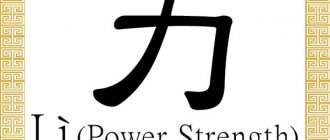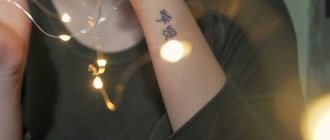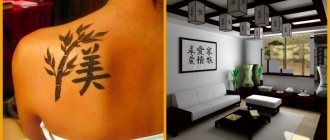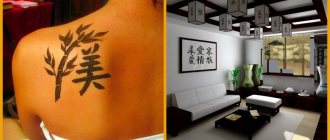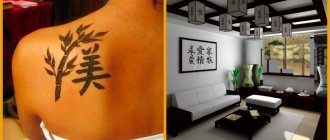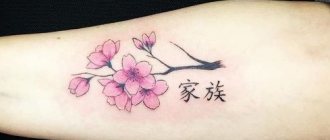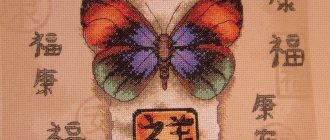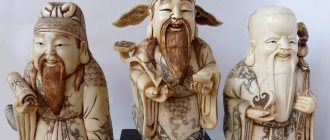Feng Shui... the philosophy of success and prosperity, the teaching of harmony and peace, the ancient Chinese science of attracting happiness and prosperity. How many sacred gifts are stored in it! The sages who created all the postulates of Feng Shui not only respected the laws of Genesis, but also took care of their safety. It is not surprising that so many different and effective ways to improve our lives have come to us. One of them is writing hieroglyphs.
For a European person, a hieroglyph is an incomprehensible combination of dashes and squiggles. However, all these keys were created for a reason, but were a prototype of the surrounding world. Each sign is a specific symbol of water, man, mountains, trees, and so on. This is why hieroglyphs have such power and are rightfully recognized as one of the most effective talismans for attracting good luck, love or happiness into your life!
Want to test their effects for yourself? Let me offer you a choice of several excellent and time-tested hieroglyphs-talismans:
Chinese symbol of love, with and without heart
New Tang Dynasty Television once broadcast news of more than 100 Taiwanese entrepreneurs living in Shanghai returning to Taiwan to hire young people to work in their companies. When asked why they had to recruit from Taiwan when there were so many talented people in Shanghai, a manager at a human resources company explained, “It's because of the wolfish nature of the youth in mainland China.” He also said that youth in Taiwan have greater creativity and greater loyalty to the company they work for.
Young people of the same race speak the same language, so why do they retain the qualities of loyalty and fidelity built into traditional Chinese culture on the one hand, but a heartless nature on the other? Perhaps we can find the key to the Chinese character 愛 (ai), which means love. The hieroglyph originally depicted a symbol that had no deep sentimental meaning associated with a person or event, rather it was an expression of gratitude from a hungry person.
When the concept of 愛 was created, the following version was first written - 㤅 (an expression of gratitude for receiving food). 旡 at the top looks like a hungry man with a big open mouth. The bottom part is the symbol 心, meaning heart, this is a literal representation of the physical heart. During the Qin Dynasty over 2,000 years ago, the image of a slow walking pace, 夊, was added at the bottom to show reluctance to part with something. This completed the final meaning - the Japanese character for "love". If one is truly in love or truly grateful, one must do it with heart.
However, in a simplified version of the Chinese character, the heart in the center has been removed:
Young people from Taiwan, Hong Kong, Macau and even Japan write the symbol of love with a heart, while young people from mainland China write "love" without a heart. This makes one wonder whether the real motive behind simplifying the Chinese script was to undermine the traditional values of the Chinese people.
Writing rules
To write characters correctly, you need to be completely proficient in calligraphy. But still, you can learn to depict some signs; for this you need to know their name and spelling. The hieroglyph love consists of 10 traits, the complex version contains all 13.
It includes:
- key graphemes (mini-hieroglyph associated with the meaning of the entire symbol);
- traits that are written in a certain direction;
- ligatures, made from dashes written together (without lifting the pen from the paper).
Imagine a square into which the symbol will fit, each part of it will take its place in the imaginary figure.
5 general rules for outline:
- Features that are at the same height are written sequentially:
- horizontal;
- vertical;
- folding
- The horizontal line is interrupted in the lower right corner and is depicted last.
- The line is drawn first, being the covering line, and the last line being covered.
- When a row consists of three lines and the extreme ones are symmetrical to each other, then the middle one is written first, and then the left and right lines.
- The line with the hook is located at the bottom right, so it is depicted as the penultimate one.
By following simple spelling, it is easy to get a beautiful and correct symbol.
INTERESTING: The hardest character to write is biang, meaning a type of noodle in one of the provinces of China; it is not in dictionaries or computer fonts due to its rare use; it consists of more than 60 strokes.
Traditions of the East
People have always been surprised by other cultures and traditions. Everything alien, at a minimum, arouses interest, and sometimes fascinates and forces you to follow you. The spiritual treasures of other cultures, not related to the Slavic ones, enter our lives with a firm and confident step, introducing a certain amount of diversity, mystery, and novelty. Take, for example, Feng Shui, designed to arrange space according to the principles of harmony and fill it with love, happiness and prosperity.
Japanese and Chinese characters for “love” are written almost identically. What is this connected with? Hieroglyphs came to Japan from China. But they were not simply copied. The Japanese have managed to introduce many poetic and personal touches that gracefully complement the traditional ancient roots. Both the Chinese and Japanese characters for "love" are very powerful and can attract these feelings into real life. Believe it or not? You decide.
History of Chinese characters
Chinese characters are a special system of graphic characters invented more than 6 thousand years ago. Hieroglyphs are considered the oldest known writings. Their invention gave impetus to the development of civilization in today's China and had a huge impact on world culture and the development of neighboring countries. The Japanese and Koreans borrowed the characters from the Chinese with minor modifications. The outlines of mountains, ponds and rivers, as well as the traces of snakes and dragons in the sand, were taken as models when applying their hieroglyphic strokes. Legend has it that it was these symbols that allowed the Chinese to learn about the structure of the world. The oldest hieroglyphs were found imprinted on the shells of turtles, and then on dishes.
The Chinese language has about 10,000 characters, of which 3,000 are the most widely used. They can be combined into many sentences. This is enough to read a modern Chinese newspaper.
Hieroglyph “love”: photo and transcript
When you look at the symbol, the following association may arise: a beautiful butterfly fluttering airily over a closed flower bud. The hieroglyph “love” is happiness and peace for existing relationships, and attracting a soul mate promises a symbol for single people. If we decipher the hieroglyph in parts, then it consists of four elements: claws, blanket, heart and friend. Love is something that very strongly and deeply, like claws, digs into the heart and covers. It's like friendship, but much more.
Hieroglyph “love”: tattoo with meaning
Dancing fancy Chinese and Japanese characters are quickly becoming one of the most famous tattoos. Nowadays, it’s quite common to see people with a tattoo that looks like a mysterious oriental alphabet. The reason for the huge popularity of such tattoos is that they are not just letters. People believe that if you hang images of Chinese and Japanese characters at home, symbolizing good luck, wealth, love, happiness, you can actually attract them into your life.
Direct application to your skin will help enhance the effect. At least that’s what those who get tattoos with Chinese characters believe. This is quite bold, it is not just wearing a T-shirt with a symbol of happiness, for example. Therefore, before you get this or that tattoo, carefully and thoughtfully study the information on the desired symbol, so that together with the hieroglyph “eternal love” you do not end up with “eternal problems”.
FENG SHUI SYMBOL VS OFFICE POLICY
Sometimes the office can be more brutal than the battlefield. You will find that a colleague takes responsibility for your work, leaving with less work and more pay.
Or it could be your boss who makes you want to tear your hair out by giving you unreasonable tasks. You may receive hostile stares, be left out of group dinners, and develop a bad reputation. All this leaves you frustrated and unmotivated, and your office life will become a nightmare.
The Rooster will help you thrive in a world of lies, betrayal and dirty tricks. This will make the office a positive place for you and will ensure that you don't get stabbed in the back at the worst possible time. The Rooster will help you sort out political problems, disputes and envy in the office or business.
Such different hieroglyphs: ideography
Hieroglyphs are not only Japanese and Chinese, there are also Egyptian, Arabic and Korean. It's kind of an elegant combination of painting and writing. It’s beautiful, but writing even a small text can take quite a long time if you do it by hand. As you know, hieroglyphs are not letters, but entire morphemes, words and even phrases.
Ideography (“writing an idea”) is a writing principle in which the unit of graphic designation is most often a whole word. It is from here that the development of writing originates. The most ancient are considered to be ancient Egyptian, Sumerian and Chinese. The first two are no longer used, but the Chinese honor the traditions of their ancestors and continue to use special characters as a modern means of writing.
Initially, hieroglyphs took the form of pictograms, simpler images of an everyday nature. However, not everything can be depicted with a picture. Difficulties arose when it was necessary to express abstract concepts in writing. For example, the symbol for “bao (guard)” is a combination of the characters for “man” and “child.”
Mysterious and beautiful Asia
For the average European, hieroglyphs are an obscure combination of dashes and hooks. But every stroke has its own meaning, every uneven loop is a prototype of the surrounding world. They are considered to be symbols and effective talismans for acquiring happiness, love, prosperity, health or wealth in a miraculous way. Take, for example, a hieroglyph to attract love. According to Feng Shui, such a powerful talisman is best hung in the southwest. You can also write it on a piece of paper and always take it with you. They say you should wear it close to your heart. Some even get a tattoo in this area.
Japanese character for "happiness"
If everything is fine with love, but you are missing a little happiness, then the Japanese character for “happiness” will help you. Here are some options for his image:
幸 and 福, and you can often find their combination 幸福.
Place it in your home and you will be happy. There is even a separate hieroglyph for “double happiness.” It is written as shown in the picture below:
Welcome to the KanjiDB Japanese character database website!
The main advantages of our project:
- Only here is unique data:
a)
all compound words without exception (and these are the majority in the Japanese language) are divided into types of readings by color: onny reading, kun reading, non-standard reading
b)
a unique method for assessing the popularity of a word is presented - each word has a rating, which is based on the frequency of use of this word in the Japanese segment of the Internet or its occurrence in Japanese newspapers - you can estimate how popular a particular word is and decide which words to learn first.
c)
most words indicate the syllable on which the stress falls.
Japanese tonic stress is one of the most difficult aspects of learning the language, largely due to a lack of information. d)
hieroglyphs are classified according to many characteristics thanks to a system of categories: new ones are added to the traditional division by readings, by keys, features and constituent elements: first of all, this is a division by lessons of popular Russian textbooks, and in the future there will be a division by semantic and other characteristics ( animals, colors, nature, mostly adjectives, mostly verbs, etc.)
— Orientation to the study of hieroglyphs and words:
a)
many hieroglyphs in the database have mnemonic story tips, thanks to which you can remember the spelling.
Moreover, hints are added both by the database authors themselves and by ordinary users - for each sign you can leave your own comment with your own version of the hint. b)
thanks to the system of personal categories, you can create any sets of signs yourself - sort hieroglyphs into shelves and select signs for training, both from publicly available category lists and from those compiled by you.
c)
a method for memorizing a hieroglyph according to the principle: the system gives you the Russian name - you tell it everything else, including the spelling.
options for memorizing kanji, when you give readings to write, showed their ineffectiveness - students could recognize the sign, but could not write. Now you can learn hieroglyphs and be sure that you really remember them. d)
the statistics of your checks are displayed on the hieroglyphs page and based on it you can conclude whether you know the sign or not. The most effective learning program is when you decide for yourself whether you have learned something or not. (in the future, the system will offer to mark some signs as learned - but the decision will still be up to the user).
And this is just what has already been done. In the future, the database will be significantly expanded and updated with new functions.
Love comes in different forms
The Japanese character for love, 愛 (pronounced ai), is a very popular choice. But it should not be confused with another image of love - 恋 (read koi), which specifically means a romantic feeling, the desire to possess the object of one’s adoration. In the first version, love is presented in a general sense, for the weather, nature, and so on, not only for a specific person.
How is it read?
Once you understand the meaning and spelling of the hieroglyph love, you can try to read it. It reads quite succinctly ai [ai], perhaps due to its components. You need to know some rules in order to interpret it correctly in various sentences. Chinese language does not imply:
- kind;
- cases;
- declinations;
- conjugations;
- numbers;
- verb tense.
All words have a certain order in a sentence; they cannot be rearranged, otherwise the expression will completely lose its meaning. This is due to the ancient origin of the language; it was formed at a time when the main means of communication were gestures.
REFERENCE: To pass the exam in China, a foreigner needs to know about 3000 characters.
Chinese philosophy
Yin Yang – Yīnyáng – 阴阳. In Chinese philosophy, Yin and Yang (dark - light, negative - positive, masculine and feminine) describe how seemingly opposing forces can actually be complementary, interconnected and interdependent in the natural world, and how they can give rise to each other as they interact between themselves. Many material dualities (such as light and dark, fire and water, expansion and contraction) are seen as physical manifestations of duality.
Some of the Feng Shui tips are:
- Don’t get carried away too much and clutter the entire space with images of happiness and good luck; use no more than three positive hieroglyphs with different meanings in the corresponding areas of the house.
- If you want to give a gift to a loved one, then send your positive vibrations along with the talisman with a mental visualization of what you wish for him.
- Connect the meaning of the hieroglyphic symbol with the image and energy of the recipient.
Hieroglyphs of love and other hieroglyph talismans
Paid surveys Miracle.money - AirDrop
Talismans
The use of hieroglyphs as talismans or talisman enhancers is not new. The language of hieroglyphs is very eloquent.
HIEROGLYPHS OF LOVE
Many people are wondering where to hang Feng Shui hieroglyphs? Hieroglyphs of love must be placed in the relationship zone, on the southwest side. Feng Shui hieroglyphs will bring maximum effect in the bedroom. Feng Shui hieroglyphs have philosophical and artistic foundations.
1. Hieroglyph “Love”: promotes long and strong love.
2. Hieroglyph “100 years of marital happiness.”
3. Hieroglyph “Eternal Love”: bestows eternal and unflagging love.
4. Hieroglyph “Love each other”: ensures mutual love.
5. Hieroglyph “I love you”: maintains the sharpness of feelings.
6. Hieroglyph "Flower": brings beauty, love, prosperity and youth.
7. Hieroglyph “Double Happiness”: helps to find your soul mate, brings harmony to family life, helps to realize the most daring joint plans.
8. Hieroglyph “Sakura”: helps to find and maintain bright and deep love.
Paintings, crystals, paired symbols carry the Feng Shui function of attracting and maintaining love, but this is not all Eastern symbolism.
Meanings of other hieroglyphs
Japanese hieroglyphs, denoting entire words, carry a certain energy that protects children and adults, home and comfort.
“Angel” is your guardian, assistant and advisor.
“Bamboo” is an oriental symbol of health, longevity, happiness, resilience and spiritual strength.
“Auspicious” is one of the most popular calligraphies. Protects against evil spirits, for success in business and personal life.
“Blessing” - grants you a blessing to fulfill your plans.
“Big Harvest” - contributes to great success and excellent results in any field of activity.
“Politeness” helps others to be mutually polite and well-mannered people.
“Spring” - this hieroglyph brings love, joy, fresh strength and renewal into your life.
"Faith". Faith will move mountains. It helps you believe in yourself, love. Justice and a bright future.
"Eternity". Let everything that brings us joy and happiness last forever.
“I love you” helps to maintain the sharpness and trepidation of feelings. A good way to declare your love.
“Wealth” - helps to gain spiritual and material wealth.
“Everything is fine” - contributes to the best flow of affairs at work and at home.
“Harmony” - helps to be in harmony with yourself and the world around you.
“Tao” (path) - creates the opportunity to follow the spiritual path to perfection, organizes and harmonizes the life situation.
“Kindness” - responsiveness, empathy, selflessness and the ability to forgive.
“Dragon” - personifies extraordinary strength and power.
“Friendship” - strengthens relationships between friends. It is favorable to give this gift of recognition to a friend or girlfriend.
“Abundance” - promotes the possession of numerous talents. The hieroglyph depicts a bowl with ears of wheat.
“Strong” – strength of will and spirit. This calligraphy promotes the development of physical strength, power and authority, perseverance, and invincibility.
“Moon” - this hieroglyph brings to our home the goddess of love, who lives on the Moon.
“Dreams” - “There is no dream that would not come true” - an Eastern proverb.
“Wisdom” - contributes to the accumulation of knowledge, life experience and its correct application in life.
“Person” - this hieroglyph helps to achieve respect and recognition in society, to be worthy of the title of a person.
“Full” - helps to ensure that there is a “Full cup” in the house.
"Prosperity". Provides growth and prosperity to everything you need.
"Forgiveness". Forgave means I understand. This hieroglyph teaches generosity, the ability to forgive and not notice the mistakes of others.
“Smooth” - promotes a smooth flow of life without unexpected fractures and turns.
"Firefly". In Japan, it is believed that the bright glow of these insects penetrates to the very heart and awakens love from sleep. Thus, calligraphy helps you find your love.
“Light of knowledge” - helps in studying.
"Able" - promotes rapid mastery of various skills and teachings.
“Happiness, Money, Love, Longevity” - four hieroglyphs bring us everything we want from life.
“Creativity” - inspiration, ideological abundance.
“Good Business” helps you find your own business.
"Purity". Cleanliness is the key to a healthy body and home. Helps improve health, clear away bad thoughts and feelings, and improve the energy of space.
“Eternal Love” - bestows the flame of eternal and unquenchable love.
“Mutual benefit” - this calligraphy promotes success in trade.
“Guru” - attracts higher patronage and people endowed with power and authority into your life. Increases social status.
“Mountain Water” - promotes financial success, ensures the safety of your property and protects vehicles.
“Business success” - contributes to better promotion of your business and career.
“Longevity” - bestows good health and long life.
"Dragon's Breath" is life energy. This calligraphy improves the overall energy of the room and brings all kinds of prosperity, happiness and well-being.
“Spirituality” - brings spiritual perfection, strength, bliss, patience, mercy, modesty, control of the senses and mind.
“Natural” - helps you to be more simple and natural in life, to feel like a part of nature.
“Health” - brings excellent well-being and good health.
“Yin-Yang” is a symbol of life, perfection, harmony, peace and harmony.
“Truth” - helps to see the true essence of current events, recognize good and evil, lies and truth.
“Fulfillment of desires” - helps to fulfill various aspirations and wishes.
“Team”, “Teamwork” - improves cooperation and mutual understanding in the team.
“Beauty” will help you achieve the beauty of your soul and body.
“Love” - helps to find long and strong love.
“Love one another”—love and be loved.
“Mother” - this hieroglyph teaches maternal love.
“Peaceful” - brings peace and tranquility to your heart and home.
“Hope” is the last bastion of success. Helps you to always be full of hope to achieve your goals.
“Education” is the foundation of the future. This hieroglyph promotes education.
“Renewal” helps to constantly change for the better, gives freshness and renewal to feelings, flexibility of thinking and versatility in the perception of the world.
"Peony" - Imperial flower. Peony is a symbol of ardent passion and undying love, wealth, glory and dignity.
“Victory” - gives you the strength to win on all fronts.
“Promotion” - this hieroglyph helps a person in his professional activities.
“Congratulations” helps all your deeds and achievements to be duly noted and recognized, stimulates you to achieve new heights in your work.
"Helping Friends" No matter what difficult situation you find yourself in, this hieroglyph will help you get help and support from friends and acquaintances.
"Invitation to Wealth" is one of the most popular calligraphies in China. The hieroglyph invites wealth to your home or office.
“Offering” - this hieroglyph brings happiness and good luck.
“Promotion” helps you never stand still, but only move forward and progress in all aspects of your life.
"Paradise". Heaven is a place of complete peace, love and happiness. Brings heavenly a into your life - this is the most favorable connection of Heaven and Earth, time and space. Bestows prosperity, great abundance and harmony.
“Growth” - grants spiritual, physical, professional and career growth, promotes business development.
“Fish” is a symbol of great luck, prosperity and prosperity.
“Sakura” will help you find such a bright and beautiful love as sakura flowers.
“Freedom” helps to be more independent in life.
"Courage". Lack of courage leads to failure. This calligraphy helps you move towards your goal without hesitation or fear.
“Family” brings peace, harmony and mutual understanding to the family.
"Cooperate." Cooperation is necessary for your activities at home or at work to be successful.
“Perfect” - helps to be a comprehensively developed person.
“Calmness” - helps to achieve a calm, measured life: good health, financial well-being and good interpersonal relationships.
"Happiness". Happiness is a need of the soul. This hieroglyph helps you find your bird of happiness.
“Destiny” helps you to believe in yourself, to be the creator of your own happiness.
"Patience". Patience and perseverance are components of a strong character that achieves success.
“Luck” - the hieroglyph brings good luck in any endeavor and success in business.
“Respect and Prosperity” - gives us respect and honor from relatives and colleagues, contributes to the growth of well-being.
"Feng Shui". One of the most popular hieroglyphs. Brings the kind of happiness and luck you desire.
“Feng Shui II” is a good “Feng Shui” for harmony in the home, so that happiness and good luck do not leave your home.
"Qi" is life energy. Improves the overall energy of the room, brings all types of prosperity and well-being.
“Clean Mind” - this calligraphy helps to keep the mind in order, relieves unnecessary worries, brings peace and enlightenment, and stimulates the intellect.
Based on materials from Internet resources
helps hieroglyph promotes love love brings hieroglyphs bestows happiness
| + |
